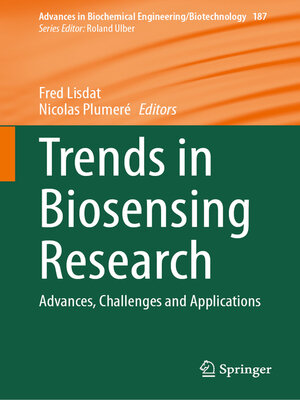Trends in Biosensing Research
ebook ∣ Advances, Challenges and Applications · Advances in Biochemical Engineering/Biotechnology
By Fred Lisdat

Sign up to save your library
With an OverDrive account, you can save your favorite libraries for at-a-glance information about availability. Find out more about OverDrive accounts.
Find this title in Libby, the library reading app by OverDrive.



Search for a digital library with this title
Title found at these libraries:
| Library Name | Distance |
|---|---|
| Loading... |
This book reviews the latest developments and applications in the field of biosensing, providing readers with an update of the earlier, successful edition, Biosensing for the 21st Century. In this book, readers will find comprehensive key information on the advances and challenges in biorecognition elements and transduction principles, including examples of new materials and new methods. Ranging from engineering chimeric enzymes to the progress in electrochemical sensing of drugs, the book discusses the latest innovations in the field and thus, provides the reader with a profound overview. In the field of biological recognition the focus will be on switchable sensors by engineering new proteins, the development of Molecular Imprinted Polymers (MIPs) for proteins or even larger biological entities, the construction of complex nucleic acid – protein structures for affinity sensing and the application of whole microbes.
The book covers new trends in signal transduction which includes graphene-based field effect transistors, nanopores designed for high selectivity and sensitivity in analysis, plasmonic and nanophotonic sensing applying metal nanostructures up to new developments in microarray construction. An introduction in to the challenges in skin-interfaced systems for continuous biochemical sensing, offers a glimpse into the future of wearable technologies. Furthermore, actual areas of application of new sensing strategies such as the detection of various types of viruses and bacteria or the analysis of drugs will be highlighted.
Each chapter provides a scholarly yet accessible perspective on the latest trends in biosensor technology. Given its breadth, the book has an interdisciplinary appeal and engages a wide readership, from students and researchers to practitioners in academia and industry, interested in the fields of biochemical/biomedical engineering and in biosensing methodologies and applications.







